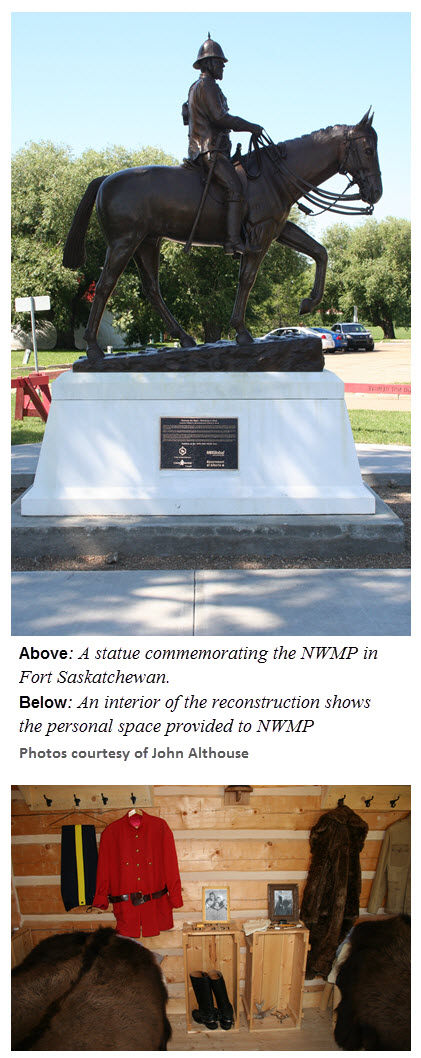Visiting Alberta’s Past :
Fort Saskatchewan
by John Althouse
Fort Saskatchewan is nestled on the east bank of the North Saskatchewan River just 32 km east of Edmonton on Highway 15. For many years, the community has been actively involved in preserving many of its historic sites, including its courthouse, the CN railway station, and the house of the warden of the former prison there. However, visitors to the site often appeared to have a single major concern. “Where’s the fort?”

The answer was simple; the last fort within the city’s boundaries was the fort developed after the arrival of the North West Mounted Police (NWMP) in the area which was torn down in 1913, a disappointment for many visitors. Well, there is no longer a need to be disappointed as the Heritage Board of Fort Saskatchewan has erected a life-sized representation of the NWMP fort. Recreation of the fort followed major historic research. On ‘the Great March West’, the new Canadian police force had quickly seen the need to divide the then-combined force. The smaller of the two groups led by Colonel Jarvis travelled to Fort Edmonton, then still an HBC fur trading fort. However, when it came time to build a permanent fort, Jarvis, an independent and stubborn man, opted to build the fort at a site northeast of Fort Edmonton, simply because everyone said that he should build at the fur-trading post. So, in 1875, the NWMP fort was constructed within the boundaries of present day Fort Saskatchewan. The city’s name was taken from that given the post.
The original fort had a life span of roughly 38 years. The fort was not static but constantly changed and evolved. When planning the recreation, the fort, a decision was which version to represent. The fort was chosen that had existed on the site for the first ten years (1875 -1885) - the end of the North West Resistance. The reconstructed fort is not exactly on the original fort site, which was also the location of the Fort Saskatchewan prison. The confines of this original site are clearly marked by gates and small bastions in the four corners. This site has been declared a heritage site - the possible target for future historic excavations. The new fort is adjacent, to the east.
The replica is now nearly complete. It is open to the general public; hours of operation can be found on the website at http://www.fortsask.ca/residents/culture/heritage/museum. There is a small charge for visiting the fort, which is paid in the office in the warden’s house. A guide accompanies visitors and provides a vivid history of the fort and its early inhabitants.
There is a surrounding stockade, and a lookout tower on the northwest corner. Inside the stockade are four buildings replicating the buildings as nearly as possible given modern building codes and safety concerns. Currently open to the public are the jail with the enlisted men’s kitchen, the enlisted men’s quarters, and the officers’ quarters. Each of these is fitted out much as it would have appeared during the period it represents 1875 – 1885. The relics in each of these buildings are not actual relics but facsimiles of these relics. For example, on one table, you will see a collection of the fire arms both rifles and pistols used by the force at this time. But if you pick them up, you will be surprised by their lightness. They are actually wood, painstakingly carved to duplicate the weapons. The largest building, the stable is not yet open. When completed (scheduled for 2015), it will serve two purposes; half of the building will provide an example of the stable as it was. The other half will serve as a museum holding Mountie memorabilia of the period.
So, if you wish to learn the colourful history of the NWMP post at Fort Saskatchewan, take some time and visit the site. You will no longer be plagued by wondering what fort? You will also come to know the importance of this center to the development of north central Alberta. You may also wish to bring out a picnic lunch and spend the rest of the day visiting the other historic buildings near fort and in the historic downtown section of Fort Saskatchewan.
There is another recent development in Fort Saskatchewan, take some time and visit the site. You will no longer be plagued by wondering – what fort? You’ll come to know its importance to the development of north central Alberta. You may wish to bring a picnic lunch and spend the day visiting the other historic buildings nearby and in the historic downtown of Fort Saskatchewan.
There is another development in Fort Saskatchewan which will be of interest to genealogists and family historians researching area families. The Fort Saskatchewan newspaper (published under a number of names) has been digitized. It is not online but may be accessed on the computers of the Fort Saskatchewan Public Library. It isn’t necessary to have a library card to use this new resource. The earliest paper dates from 1903, with a few gaps. but most newspapers from 1905 to the present are in the archive.
Originally appeared in Relatively Speaking, v.43 #1 (Feb 2015)
